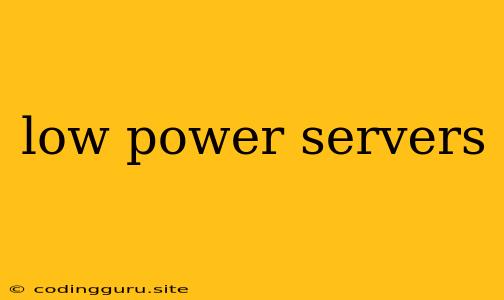Low Power Servers: Your Guide to Efficiency and Cost Savings
In the world of technology, efficiency and cost savings are paramount. Especially when it comes to the data centers that power our digital world. This is where low power servers come in. But what exactly are they, and what benefits do they offer?
What are Low Power Servers?
Low power servers, as the name suggests, are designed to consume less energy than traditional servers. This is achieved through various design optimizations, including:
- Efficient Processors: These servers utilize processors specifically designed to minimize power consumption while maintaining high performance.
- Optimized Cooling Systems: Low power servers often incorporate advanced cooling solutions like heat sinks and fans, reducing energy wasted on cooling the system.
- Power-Saving Features: They may feature power-saving modes that automatically reduce power consumption during periods of low activity.
Why Choose Low Power Servers?
The benefits of using low power servers are numerous:
1. Reduced Energy Costs: The most significant advantage is the reduction in energy consumption, translating to lower electricity bills.
2. Environmental Sustainability: By reducing power consumption, you contribute to a greener footprint and lessen your environmental impact.
3. Improved Efficiency: Low power servers can often achieve comparable performance to traditional servers while consuming less energy, leading to a more efficient setup.
4. Lower Operating Costs: Reduced energy consumption contributes to lower overall operating costs, making these servers a cost-effective solution in the long run.
5. Enhanced Durability: Since they generate less heat, low power servers can have a longer lifespan, reducing the need for frequent replacements.
Choosing the Right Low Power Server
The selection process for a low power server depends on your specific needs:
- Performance Requirements: Determine the processing power and memory capacity needed for your applications.
- Power Consumption Targets: Set a clear goal for the desired reduction in energy consumption.
- Scalability: Consider the potential for future growth and whether the chosen server can accommodate your needs.
Tips for Optimizing Low Power Servers
- Virtualization: Consolidate multiple applications on a single server to maximize resource utilization.
- Power Management Settings: Utilize power management features to adjust energy consumption based on workload.
- Energy-Efficient Components: Opt for energy-efficient peripherals like hard drives and network cards.
- Regular Maintenance: Keep your servers clean and well-maintained to ensure optimal performance and efficiency.
Examples of Low Power Server Applications
1. Small Businesses: Low power servers are ideal for small businesses with limited budgets and space, providing a cost-effective and sustainable solution.
2. Home Labs: For enthusiasts and hobbyists, low power servers offer a powerful yet energy-efficient platform for personal projects.
3. Edge Computing: In edge computing deployments, low power servers are crucial for managing data closer to the source while minimizing energy consumption.
Conclusion
Low power servers offer a compelling alternative to traditional servers, providing significant benefits in terms of energy efficiency, cost savings, and environmental sustainability. By carefully considering your needs and adopting best practices, you can leverage the power of low power servers to optimize your infrastructure and contribute to a more sustainable future.
